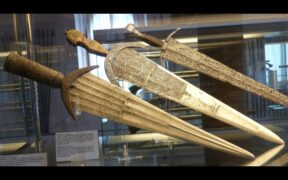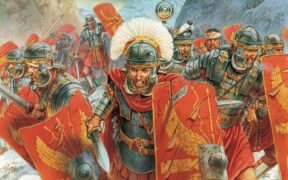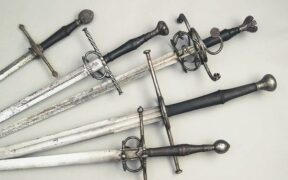Our content features commercial links to our products, committed to transparent, unbiased, and informed editorial recommendations. Learn More
12 Types of One Handed Swords: A Comprehensive Overview
NO AI USED This Article has been written and edited by our team with no help of the AI
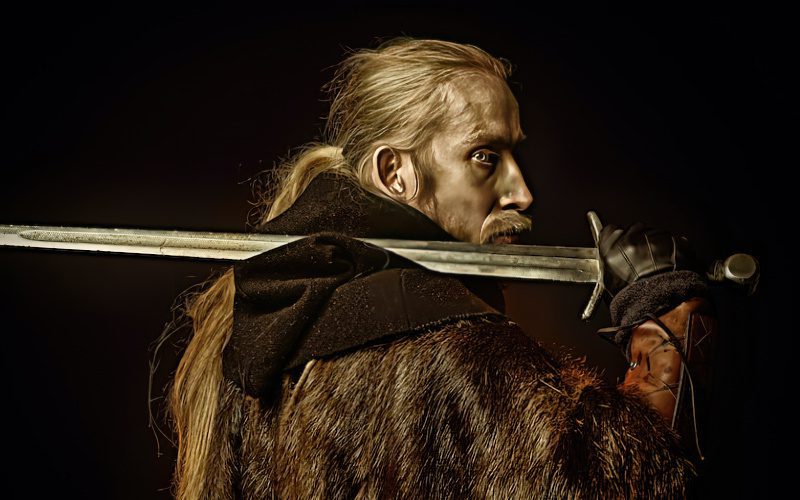
One-handed swords refer to the swords wielded using one hand. In the early medieval times, the single-handed grip allowed the use of a shield and other companion weapons on the other hand. Eventually, the sword became the same weapon for attack and defense.
Let’s explore the different types of single-handed swords, their historical uses, and how they compare with two-handed swords.
Types of One-Handed Swords
One-handed swords allowed both hands to act independently from one another and varied in their use in sword fighting. Some originated in ancient times, while others emerged in the medieval and Renaissance periods.
1. Viking Sword
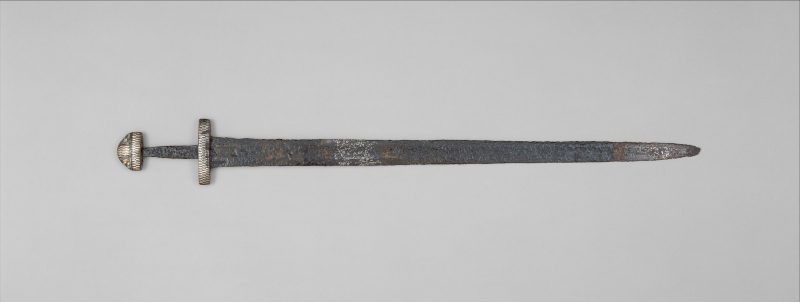
Evolved from the Roman cavalry sword spatha, the Viking sword was among the weapons used throughout the Viking Age, from the 9th to the 11th century. It was a single-handed weapon, so the Viking warrior used his other hand to hold a shield. Hacking blows were a common fighting technique of the Vikings, so they likely used their swords as slashing weapons.
Viking swords had relatively wide, heavy blades and a short handguard. Some were single-edged or double-edged, with the former more typical in Norway than in other parts of Scandinavia. These swords had a lightweight pommel, which shifted the balance toward the tip, optimizing them for slashing. Still, their rounded tips could also thrust well against unarmored targets.
However, many Viking swords were easily bent, so the warriors often straightened it themselves. Viking chieftains traditionally owned ornate swords for ceremonial occasions, though the warriors also used the weapon in dueling. The Vikings also used a fighting knife called sax or seax, which would have been efficient in close-quarters combat.
2. Arming Sword
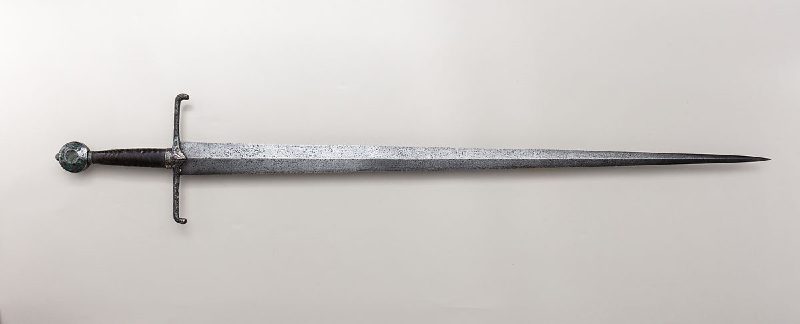
The classic weapon of the medieval knight, the arming sword is recognized for its simple, cruciform shape and one-handed grip. Also called the knightly sword, it served as a secondary weapon after the lance broke or in close-quarters combat. Arming swords generally had a straight, double-edged blade suited for slashing blows against mail armor, composed of hundreds of linked iron rings. It was often used with the buckler, a small hand shield.
The famous sword of King Henry V of England is a classic arming sword with an acutely tapering blade. The arming sword was also the typical crusader sword of the Knights Templar—the first military order founded in 1119 and named after the Temple of Jerusalem. Early crusader swords had a relatively broad blade, but swords of the late crusading period usually had pointed tips, better suited to thrusting against plate armor.
3. Falchion
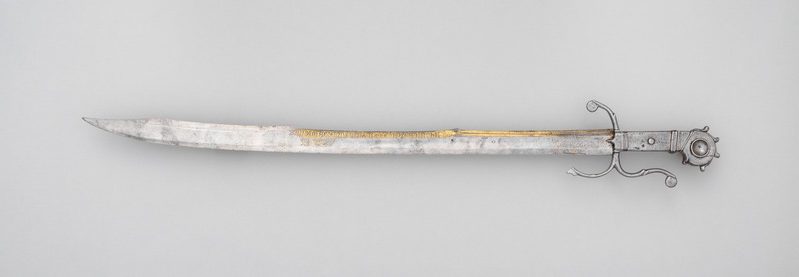
Most recognized for its broad blade flared at the point, the falchion developed from the Norse sax and derived from the Greek kopis. In the later Middle Ages, falchion had two distinct blade forms—a machete-like cleaver and a clip-point style. The knights and light troops, such as archers and spearmen, used the falchion on the battlefield.
Cleaver-shaped blades were heavy and unbalanced for thrusting. However, falchions with a clip point—or the back edge cut away, giving it a cusped, beak-like shape—were efficient for cutting and thrusting. Cleaver-like forms were rarely seen after about 1370, while the clip-point style remained in use.
4. Lange Messer

In medieval Germany, commoners carried a messer as a sidearm. The term messer literally means knife, though it belonged to a family of cutting weapons of different sizes. The lange messer was a one-handed, single-edged sword with a simple cross hilt. On the other hand, the kriegsmesser or war knives were large enough to use two-handed, rivaling a longsword in size.
The messer often had a slightly curved blade and was efficient for slashing, powerful enough to slice off a hand from the arm with a single blow. The sword and buckler combination was common across Europe, but fencing with a messer was an exception.
In sword practice, the hand was likely the principal target, and combatants often needed gauntlets. The messer was traditionally carried in one hand with the other hand behind the back, as commonly seen in modern saber fencing. An alternative to wearing gauntlets was to use a wooden dussack that has blades that are often more curved than the messer.
5. Katzbalger
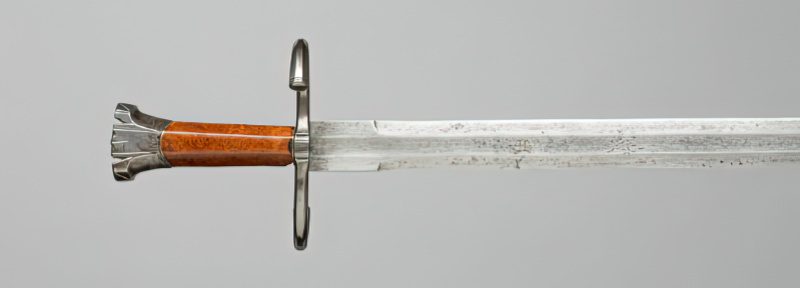
Most recognized for its s-shaped or figure 8-shaped guard, the katzbalger was the short sword of the Landsknechts—German mercenary fighters of the late 15th and early 16th centuries. The standard battlefield tactic of Landsknechts was a phalanx of pikemen, though some soldiers carried the short sword as a sidearm for close-quarters combat.
The name katzbalger comes from the German words katze and balg, meaning cat and skin or fur of an animal, respectively. It was probably derived from the custom of carrying a sword without scabbard, only held by a cat’s skin. It could also be associated with the modern German term katzbalgen, meaning brawl or scuffle, which describes the use of the sword.
The katzbalger had a broad, double-edged blade designed for slashing. The archers, crossbowmen, and pikemen used the short sword when their enemy got too close for bows and pikes to be efficient. On the other hand, the doppelsöldners, meaning double-pay men, wielded the great sword zweihander to smash their way into enemy ranks.
6. Basket Hilted Broadsword
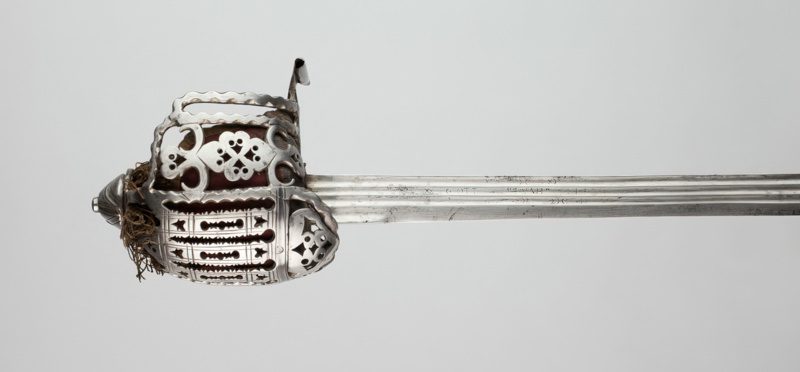
During the mid-16th century, basket-hilted broadswords were widely used throughout Europe, though they became more associated with the Scottish Highlanders. The basket-hilt guard was designed to protect the swordsman’s hand. The military tactics of the Scots were often influenced by their weapons and resources.
In Scotland, single-handed basket-hilted broadswords developed due to the preference for light weaponry and minimal covering of armor. Soldiers needed to march for considerable distances and two-handed swords were hard to wield. The single-handed sword also allowed the use of a Scottish dirk or dagger in the other hand, often with a targe or shield.
Schiavona

Another famous type of basket-hilted sword is the Italian schiavona, meaning Slavonic, a reference to the Dalmatian troops who used them in the service of the Venetian Republic. The Venetian broadsword has a distinctive form of basket hilt and almost always features a pommel resembling a cat’s head.
Mortuary Sword
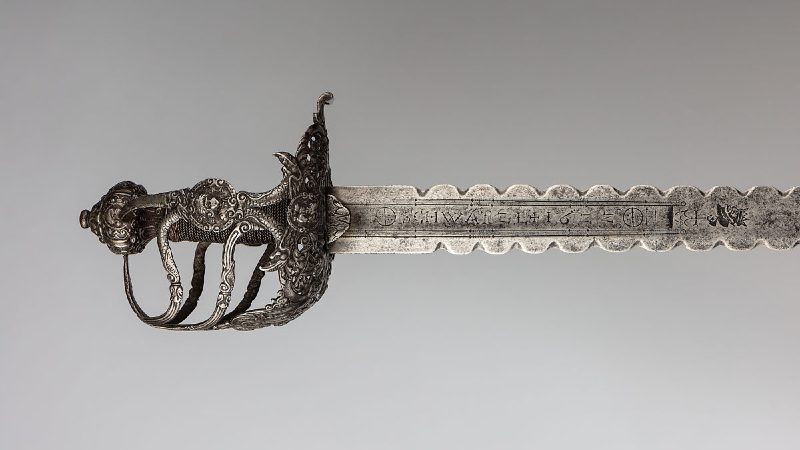
Many cavalrymen during the English Civil War used the mortuary sword, named because it resembled the death mask of the executed King Charles I. It often featured a half-basket hilt resembling the human rib cage and a grotesque mask uniquely of English design.
7. Rapier
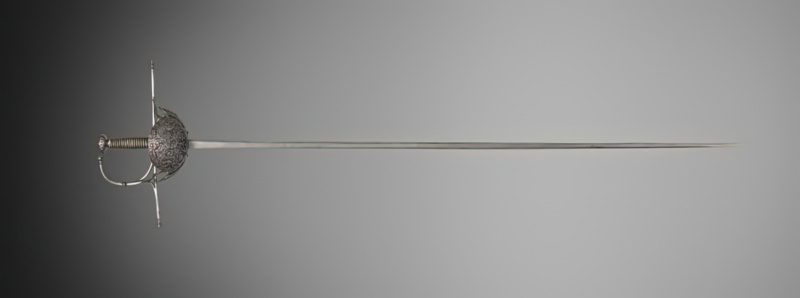
By the 16th and 17th centuries, rapier became a weapon of a gentleman. It was more associated with fashion, court, and dueling, but was also an efficient self-defense weapon for unarmored civilian combat. The name comes from the Spanish term espada ropera, meaning sword of the robes.
Rapiers are thrusting swords with very narrow blades and sharp tips. They also had a one-handed grip with varying hilt designs, from cup-shaped to swept-hilt, and so on. In Spain, cup-hilt guards were most popular, while in Italy, the classic form was swept-hilt.
Early fencers used rapiers with a parrying dagger to ward off an attack. The left-hand Spanish dagger, the maingauche, often matched the cup-hilted rapiers in design. Some fencers even utilized a buckler or a cloak.
8. Smallsword
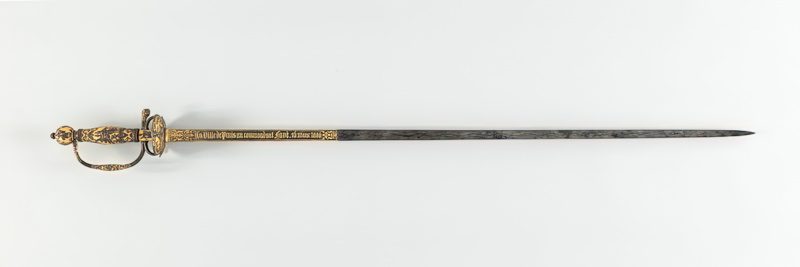
Evolved from the longer rapier, the smallsword is a one-handed sword designed for thrusting. It came into general use in Western Europe toward the end of the 17th century. As a fashion accessory, it also served as a badge of status and a reflection of wealth.
Most recognized for its small cup and knuckle guard, the smallsword was a dueling sword and a civilian weapon. It has a triangular blade without sharpened edges. The colichemarde type features a broad forte, which was used for parrying an opponent’s sword.
9. Kilij
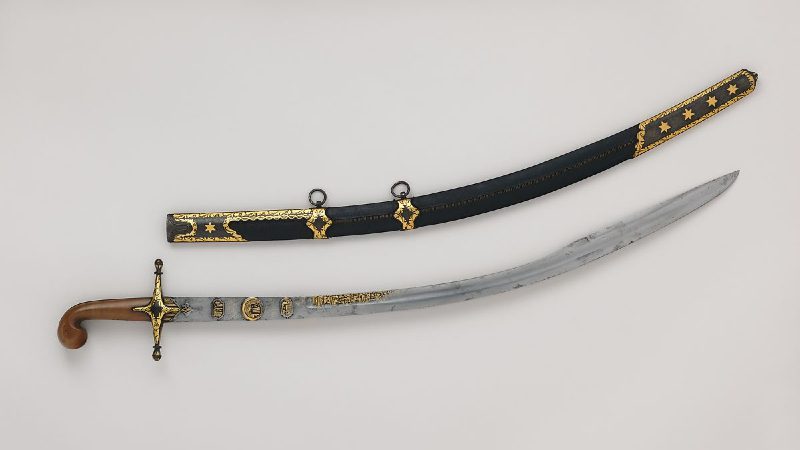
The Islamic world had several one-handed swords. The Ottoman Empire ruled large regions of Eastern Europe, the Middle East, and North Africa, and the Turks used curved swords that reflected their origins. They first used the kilij in the 15th century, though similar weapons were also used across the Islamic world.
The kilij features a pistol-style grip and a blade with a deep curve cut along its back edge, flaring into a yelman toward the tip. The Ottoman cavalry was skilled in wielding the kilij, which could sever a head with a single stroke. They also used long spears and bows and protected themselves with long coats of chains.
10. Shamshir
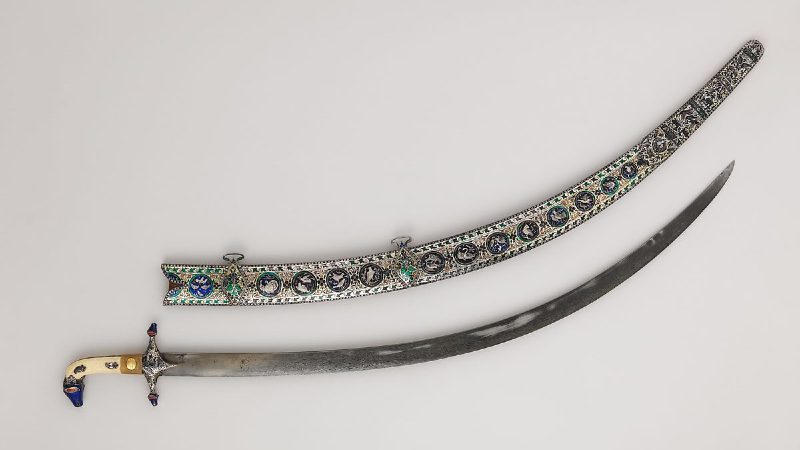
In the 16th century, the shamshir, a type of saber, spread from Persia. It typically had a pistol-style grip similar to kilij but featured a deeply curved tapering blade. It was an efficient slashing weapon whether on horseback or foot as a cavalryman could use the blade’s tip to run an enemy foot soldier through.
11. Talwar
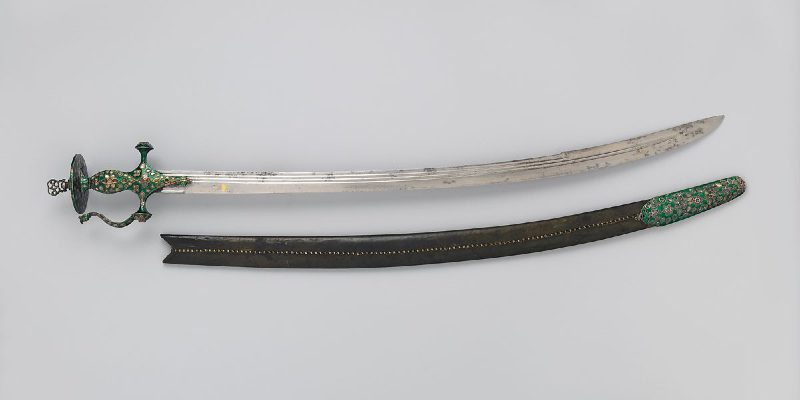
Most recognized for its disc-shaped pommel with a spike, the talwar or tulwar, was the typical sword of the Mughal Empire that dominated India. When the British East India Company expanded its power over most of India by the late 18th and 19th centuries, the talwar remained in use. Some British officers even took them home as souvenirs.
The talwar usually has a relatively broad and moderately curved blade, though several Indian blades including the sirohi, tegha, and sosun pattah, are often equipped with a talwar hilt. It was an efficient slashing weapon and could easily split helmets with a single blow.
12. Shashka
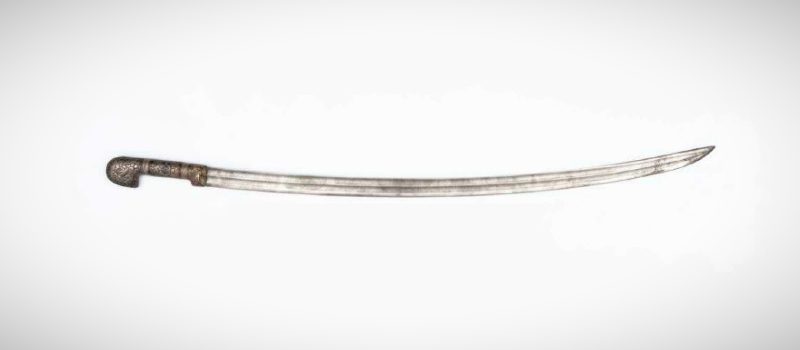
The shashka or shasqua was the typical sword of the Cossack, Russian, and Ukrainian people recognized for their swordsmanship and military skills. It features a saber-like blade and a one-handed grip. However, it lacked a sword guard, making it appear like a big knife.
The Cossacks traditionally wore their shashka with the cutting edge facing up and used it for slashing while on horseback. Once dismounted, the warriors would use the short sword kindjal. They were even recognized for their saber charges during World War I.
Characteristics of One-Handed Swords
The most notable feature of one-handed swords is their short, single-handed grip. However, they greatly varied in construction, blade appearance, and hilt design, depending on the sword type and origin.
Here are the general characteristics of one-handed swords:
Metal and Construction
The Viking sword usually had pattern-welded blades, resulting in decorative patterns. Early medieval swords had blades with an iron core and steel edges as swords made entirely of steel were not typical before the 14th century. On the other hand, historical Islamic swords were often made from the ancient Indian wootz steel and had damascus steel blades, some with a watery pattern.
Many basket-hilted broadswords had German blades produced in Solingen and attached to locally-made basket hilts. The Scottish basket hilts were often made in the lowlands, mainly in Stirling and Glasgow. Also, mortuary swords are uniquely English in design, though their blades were manufactured in Germany.
Modern reproductions of one-handed swords often feature hand-forged and high-quality carbon steel blades. However, the so-called battle-ready swords used for backyard cutting practice must have properly tempered blades. On the other hand, practice swords used in Historical European Martial Arts or HEMA must have flexible blades that bend when thrusted.
Blade Appearance
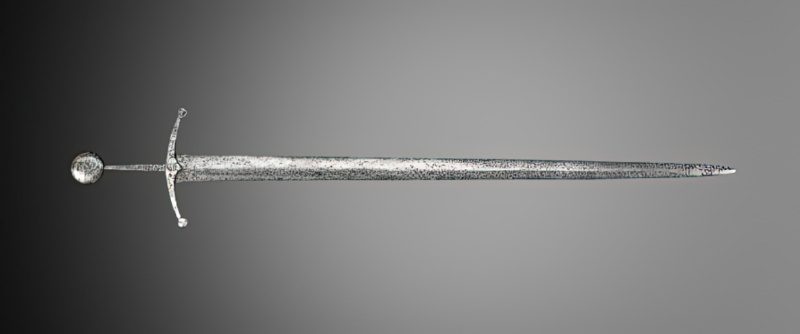
Chainmail and plate armor influenced sword blade designs. Historian Ewart Oakeshott even established the typology of swords based on their blade and function. In early medieval times, one-handed swords tended to be broad-bladed, designed to hack through chain mail armor. When plate armor became popular, sword blades became narrower and more suited to thrusting as slashing swords were inefficient against it.
The blades of a one-handed arming sword also evolved parallel with the longsword, a type of sword that allowed the use of two hands. By the 16th and 17th centuries, sword blades developed into rapiers. Double-edged broadswords often designed for cavalry use, emerged from the 1600s through the 1800s. Also, many Islamic swords were curved, including the Ottoman kilij and Persian shamshir.
Size and Length
One-handed swords have a single-handed grip but widely vary in blade length. Many erroneously refer to the arming sword as a short sword to set it apart from the longsword with a longer grip which allows a two-handed use. However, the arming sword has a long blade, usually around 70 to 80 centimeters (27 to 31 inches).
Sword Mounting
One-handed swords varied in hilt and guard designs, from the typical cross guards of medieval swords to swept hilts of rapiers and basket hilts of broadswords. The basket hilt provides excellent protection and is often lined with felt-covered leather on the inside.
Some Italian schiavona featured high-quality silverwork, suggesting they were an officer’s weapon. On the other hand, the mortuary sword featured a grotesque mask, often with leafy decorative scrollwork.
The Ottoman kilij and Persian shamshir often had a pistol-style grip or L-shaped pommel while the Indian talwar had a disc-shaped pommel and single-handed vase-shaped grip. The shashka is also distinguished for its lack of sword guard.
One-Handed Sword vs. Two-Handed Sword
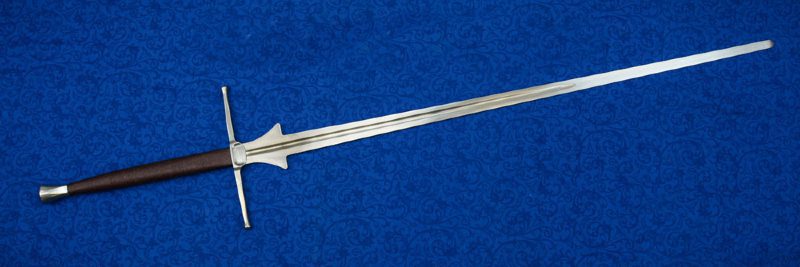
The difference between a one-handed sword and two-handed sword is basically their grip. However, both have their own set of advantages and disadvantages depending on the specific type of sword, its use in combat, and the type of armor.
The longsword is lightweight enough for single-handed use, but its longer grip allows two-handed use. Many associate the longsword with the bastard sword or hand-and-a-half sword, which fencing master Joseph Swetnam described as shorter than longswords.
On the other hand, the great swords such as the German zweihander and the Highland claymore are commonly referred to as two-handers, but their grips do not merely accommodate just two hands. In fact, they are extremely large swords and not carried in a scabbard from the belt.
While a one-handed sword is a lightweight weapon, just like an arming sword, it requires greater effort from a wielder’s hand, wrist, and forearm. On the other hand, a longsword with a two-handed grip distributes the weight in both hands, making it more maneuverable.
